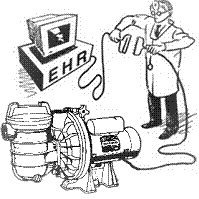The article about Pediatric Associates in CA has a nugget with a potentially outsized impact: the implication that VFC vaccines…
Intelligent Healthcare Information Integration 6/20/09
Pool Pumps and EHRs
Never having owned a swimming pool before — kiddie blow-up pools notwithstanding –I had no clue about anything pool when we moved to a home with our first “cement (pronounced “see-ment”) pond.” Being in Smalltown, Ohio, where ‘pool guys’ are something we only hear about on Nip/Tuck, I had no options other than to learn my way around pool care, including chemistry, biologicals, skimmers, hoses, filters, jets, and pumps.
 Turns out the pool pump we inherited, besides being old and inefficient, had been wired poorly and was using far too much juice. When our summer electric bills pushed us toward bankruptcy, I studied up on newer pools pumps and decided to purchase a “smart” pump which promised “up to 90% savings” on our electricity tab.
Turns out the pool pump we inherited, besides being old and inefficient, had been wired poorly and was using far too much juice. When our summer electric bills pushed us toward bankruptcy, I studied up on newer pools pumps and decided to purchase a “smart” pump which promised “up to 90% savings” on our electricity tab.
Savvy enough to have a certified-smart, real electrician convert my wiring run and circuit breakers from 120 volt to the required 240V, I chose to do the actual pump installation and final wiring to the outdoor switch on my own. (No, this isn’t leading to a tale of emergency squads and defibrillations!) With a broad smattering of electrical and electronic training and a general understanding of electrical codes, hots, grounds, and safe wiring habits, the job was not the greatest of challenges but was still not the simplest or least nerve-wracking of installations. Fortunately, it powered up without a spark and seemed to work.
Afterwards, I relaxed in the hammock listening with some small sense of self-accomplishment to the much more muted hum of our new, high tech, energy-saving, self-adjusting, computerized pool pump. But, now, with the new, high end tool online and operational, I still had to figure out just how to decipher and adjust all of those new pump-puter settings and codes to optimize my chances of achieving the 90% savings advertised.
The manual seemed complete, all 60 pages of it. Predictably, though, the typically poor tech writer-to-lay person interpretation skills were in full swing, so I found myself looking online for deeper insights and better explanations. This did help, but I’m still not sure if I am using, or even understanding, all of the available digital tweaks and tools this of fancy new gizmo.
You see, I’m sure, where this is heading. With something as relatively simple as a pool pump and with someone who has a generally workable background in electronics and computers, the challenges of digitization and the learning curve for its incorporation are not irrelevant, not even minor. Why, then, is it such a surprise that medical providers, who typically boast minimal-to-no I.T. background, have such trouble adopting, no less understanding, VASTLY more complex electronic healthcare tools?
How are healthcare providers ever going to achieve HIT competency and EHR satisfaction … two weeks of on-site training, hard-to-reach support call centers, and a written-by-techies manual? These are the typical answers which most EHRcos have concluded are sufficient to bring healthcare workers across the digital divide. That’s about what most of us could use to competently install and utilize one of these fancy-schmancy, cement pond pumps. I’m thinking a better training, support, and ongoing education plan might be required for the complexities of HIT.

Dr. Gregg Alexander is a grunt-in-the-trenches pediatrician and geek. His personal manifesto home page…er..blog…yeh, that’s it, his blog – and he – can be reached through http://madisonpediatric.com or doc@madisonpediatric.com.

Dr Alexander, I couldn’t agree more. ARRA is putting the cart before the horse. What’s needed is an incremental approach to EMR implementation that builds value as each step is achieved. Otherwise you have inconsistent partial usage, features that aren’t being used, and confusion and disappointment without knowing how to fix it. The first phase involves a 100% uptime, essential information entered as discrete data, and an organizational committment to sustainability components like ongoing training and updating of clinical lists and templates. Without those benchmarks being achieved, there’s no hope of getting interoperability or even consistent quality improvement down the road.
Agreed, Bignurse. We didn’t start out paying bills and transferring funds online; we started with a wonderfully convenient new tool that provided real and immediate value – the ATM. Seems to me we need the EHR version of such real, easily understood, and usable value first. Follow that with some McGuffey Readers for EHRs and a solid system of CONTINUING education for their 3 R’s (reading, ‘riting, & retrieving) before we have this whole “use ’em or lose” conversation.
It’s as if we’re going to punish the illiterate for their ignorance without offering them any education, or, like forcing folks to take college finals before they’ve even learned the alphabet.